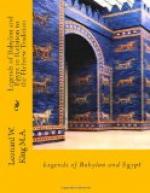The creation of small rivers and pools, which seems to have followed the foundation of the five sacred cities, is best explained on the assumption that they were intended for the supply of water to the cities and to the temples of their five patron gods. The creation of the Euphrates and the Tigris, if recorded in our text at all, or in its logical order, must have occurred in the upper portion of the column. The fact that in the later Sumerian account their creation is related between that of mankind and the building of Nippur and Erech cannot be cited in support of this suggestion, in view of the absence of those cities from our text and of the process of editing to which the later version has been subjected, with a consequent disarrangement of its episodes.
III. THE COUNCIL OF THE GODS, AND ZIUSUDU’S PIETY
From the lower part of the Third Column, where its text is first preserved, it is clear that the gods had already decided to send a Deluge, for the goddess Nintu or Ninkharsagga, here referred to also as “the holy Innanna”, wails aloud for the intended destruction of “her people”. That this decision has been decreed by the gods in council is clear from a passage in the Fourth Column, where it is stated that the sending of a flood to destroy mankind was “the word of the assembly (of the gods)”. The first lines preserved in the present column describe the effect of the decision on the various gods concerned and their action at the close of the council.
In the lines which described the Council of the Gods, broken references to “the people” and “a flood” are preserved, after which the text continues:
At that time Nintu (.
. .) like a (. . .),
The holy Innanna lament(ed)
on account of her people.
Enki in his own heart
(held) counsel;
Anu, Enlil, Enki and
Ninkharsagga (. . .).
The gods of heaven and
earth in(voked) the name of Anu and Enlil.
It is unfortunate that the ends of all the lines in this column are wanting, but enough remains to show a close correspondence of the first two lines quoted with a passage in the Gilgamesh Epic where Ishtar is described as lamenting the destruction of mankind.(1) This will be seen more clearly by printing the two couplets in parallel columns:
SUMERIAN VERSION SEMITIC VERSION
At that time Nintu (. . .) Ishtar cried aloud like a woman like a (. . .), in travail, The holy Innanna lament(ed) Belit-ili lamented with a loud on account of her people. voice.
(1) Gilg. Epic, XI, l. 117 f.




